Table of Contents
|
Jefferson,Bond Lake,Oak Ridges
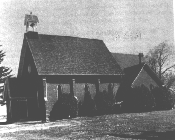 |
| St. John's
Anglican Church,Jefferson. |
Yonge Street north of
Elgin Mills supported a
number of small settlements in the middle of the nineteenth century, each with
its own claim to continuing fame. Opposite
Jefferson
Sideroad,
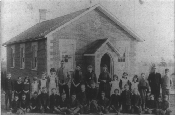 |
| Pupils of
Jefferson
Public School. |
St. John's
Anglican Church offered spiritual comfort to the weary traveller.
Erected as a wooden frame structure in 1848, the now brick-clad building is the
oldest church edifice in present-day
Richmond Hill.
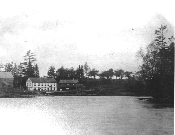 |
| Bond Lake
Hotel and stables. |
At
Bond Lake, comfort of
another sort awaited travellers at the well-known
Bond Lake Hotel.
Built in 1834, the hotel boasted twenty overnight rooms, plus a grand ballroom,
and provided the setting for local dances and sleigh-ride parties. Nearby was
the fifty-five-acre (twenty-hectare) spring-fed lake itself, which attracted
generations of nineteenth-and early twentieth-century swimmers
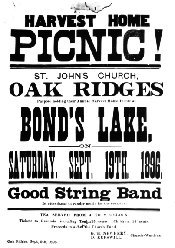 |
| Poster for a picnic at
Bond Lake |
and boaters in summer months, while curlers and skaters
used its frozen ice for their winter sports.
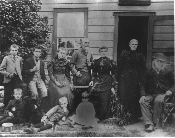 |
| The Routledge family of
Oak Ridges. Pictured
left to right are: mail carrier
C. Harper,Hettie
Routledge,Marsh
Routledge on the grass,
Charlie
Routledge,Emma
(Mrs. Peter) Routledge,Lucy
Routledge,Peter
Routledge,John on
the grass,
Mary Jane
Routledge (Peter's sister), and
Watson on the grass.
Peter
Routledge was appointed postmaster at
Oak Ridges in 1889,
and ran the mail operation from his home. |
At
Oak Ridges, the
mid-nineteenth-century traveller encountered a community nucleus of a hotel,
post
office, and blacksmith shop. In the early years of the twentieth
century, this emerging community would profit from its location at the junction
of the
Metropolitan
and
Schomberg & Aurora electric railway lines and from
its proximity to summer cottage development around
Lake Wilcox. Still
later, in the closing decades of the twentieth century,
Oak Ridges would become
Richmond Hill's major
northern commercial and residential area.
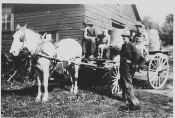 |
|
Routledge's blacksmith shop at
Oak Ridges, with
Walter Mortson
in front. |
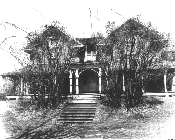 |
| Drynoch, the residence
of Captain
Martin
Macleod, west of
Yonge Street and
north of
Jefferson
Sideroad. Macleod built the home in 1846, named it after his home estate
in Scotland, and made it the headquarters of his vast 600-acre (about
240-hectare) Canadian farming operation. One of his sons, Colonel
James
Macleod, achieved fame with the North-West Mounted Police and came to be
regarded as a founding father of southern Alberta. |
Previous
Next
Copyright © Richmond Hill Public Library Board, 1991
|

